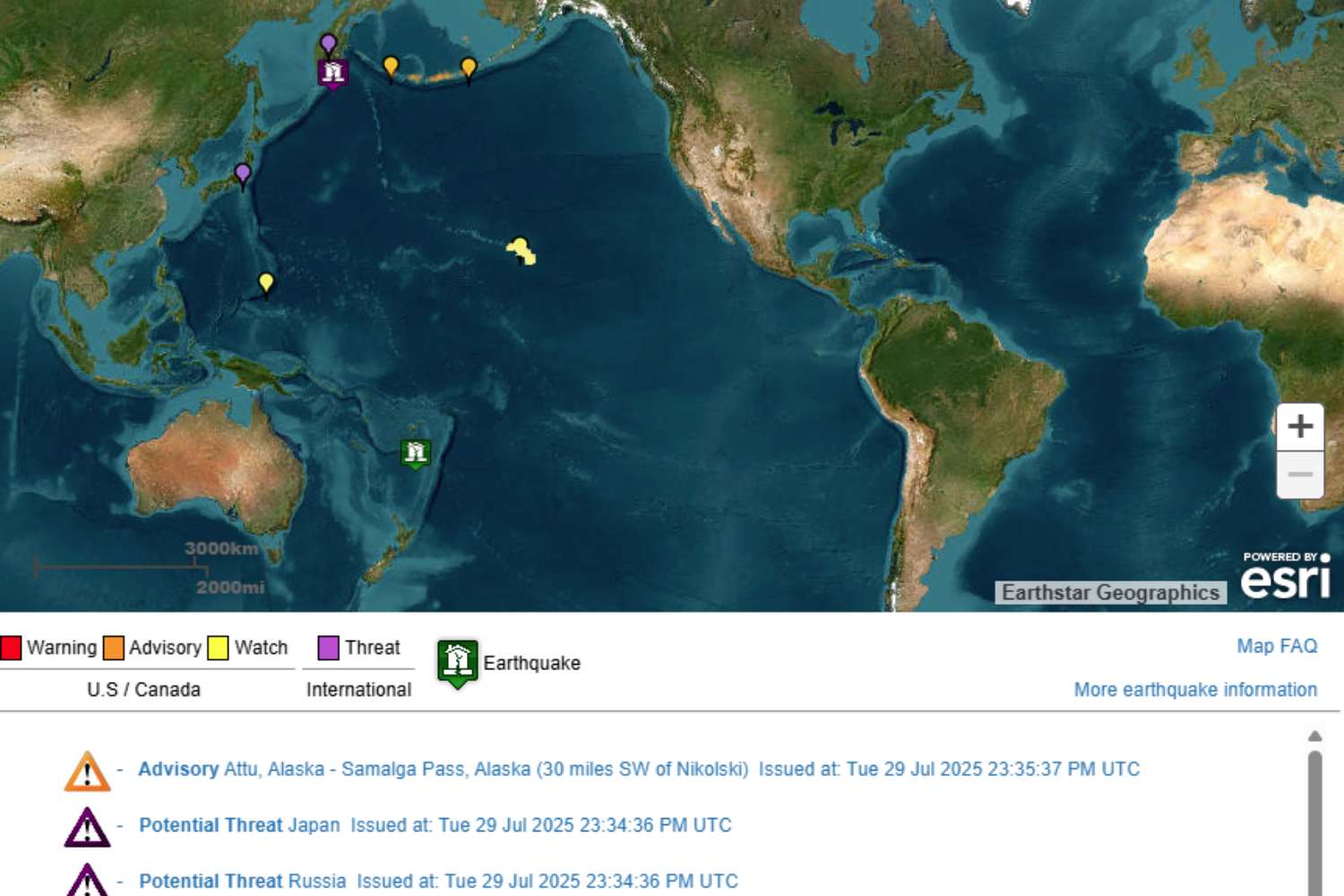A powerful 8.8-magnitude earthquake struck Russia's Far East, triggering a tsunami alert across the Pacific, with widespread evacuations and disruptions from the U.S. to Asia.

@NWS_NTWC/X
A violent earthquake measuring 8.8 in magnitude struck Russia’s Far East, specifically off the Kamchatka Peninsula, early this morning, July 30, 2025. The epicenter was located about 119 kilometers (74 miles) east of Petropavlovsk-Kamchatsky, at a depth of just over 20 kilometers (12 miles). This marks the strongest earthquake recorded in the region since 1952, followed by dozens of aftershocks, some reaching magnitudes above 6.9.
🔴🔴 [DATI #RIVISTI] #terremoto Mwpd 8.4 ore 01:24 IT del 30-07-2025 a Off east coast of Kamchatka Peninsula, Russia [Sea: Russia] Prof= 2.3 Km #INGV_43566512 https://t.co/hNLZHjPUoe
— INGVterremoti (@INGVterremoti) July 29, 2025
🔴🔴 [DATI #RIVISTI] #terremoto mb 5.6 ore 02:16 IT del 30-07-2025 a Off east coast of Kamchatka Peninsula, Russia [Sea: Russia] Prof= 29.7 Km #INGV_43567612 https://t.co/qiTpvMfTla
— INGVterremoti (@INGVterremoti) July 30, 2025
Tsunami alert across the pacific
The quake immediately triggered a tsunami warning for dozens of countries bordering the Pacific, including Russia, Japan, the Hawaii Islands, Guam, Alaska, California, Ecuador, Chile, and even the Galapagos Islands. According to the U.S. Geological Survey, tsunami waves measuring between 3 to 4 meters (10 to 13 feet) were recorded in the Russian Elizovsky district, while Severo-Kurilsk was flooded.
In Japan, the National Meteorological Agency (JMA) issued evacuation orders for more than 1.9 million people, with tsunami waves reaching 60 centimeters (24 inches) on Hokkaido. As a precaution, the Fukushima nuclear power plant, site of the 2011 disaster, was evacuated.
At least 4 whales have washed up along the coast of Japan, hours after 8.8 earthquake
Civilians seen on top of building in Hokkaido, Japan amid tsunami warning.
Tsunami Warning ⚠️ Russia, Alaska, Hawaii, Japan #earthquake #tsunami #Russia #Japan #Hawaii #Alaska pic.twitter.com/3BhfkszQjz
— Sumit (@SumitHansd) July 30, 2025
Evacuations and blackouts in Russia
Kamchatka’s region has activated its emergency protocols. Governor Vladimir Solodov urged people to move away from the coast and follow the warnings from the alert systems. In Petropavlovsk-Kamchatsky, a city of over 180,000 inhabitants, there are reports of blackouts, communication failures, and damage to public buildings, including preschools and schools. Fortunately, no fatalities have been reported so far, but many have been injured, most with minor wounds.
Horrible, Another video showing the M8.8 earthquake that hit off the coast of Kamchatka, Russia
Hawaii, Alaska, Japan has been issued a tsunami warning following Russia earthquake.#earthquake #tsunami #Russia #Japan #Hawaii #Alaska pic.twitter.com/IGbGHtUwNV
— Sumit (@SumitHansd) July 30, 2025
Global impacts: from the United States to Asia
The first tsunami waves reached the Aleutian Islands in Alaska, spreading towards California, where an unusual sea withdrawal was observed. In Hawaii, where sea levels suddenly dropped, authorities ordered the closure of all ports and activated emergency shelters.

In the United States, an alert was issued through tsunami.gov, and former President Donald Trump, via his social media platform Truth, urged citizens to “stay safe.” Emergency services in California, Oregon, and Washington suspended beach access and activated coordination centers.
One of the strongest seismic events in decades
This earthquake ranks among the top ten strongest ever recorded in modern history. It is the strongest since 2011, when Japan experienced a 9.1 magnitude quake, resulting in over 19,000 fatalities and the Fukushima nuclear disaster. According to the Geophysical Service of the Russian Academy of Sciences, this is a unique event, with aftershocks potentially continuing for up to a month, possibly reaching 7.5 in magnitude.
Impacts in Asia, South America, and Oceania
The alert also affected Shanghai, which was hit simultaneously by a tropical cyclone. In Latin America, Peru, Ecuador, and Mexico have activated evacuation plans and urged people to leave beaches and ports. Authorities across the Pacific, including New Zealand, French Polynesia, and the Philippines, are on highest alert.
The Mexican Navy forecasts waves between 30 to 100 centimeters (12 to 40 inches), while in Ecuador, all coastal activities have been suspended. The Galapagos Islands, a UNESCO World Heritage Site, have ordered the complete evacuation of low-lying areas.
